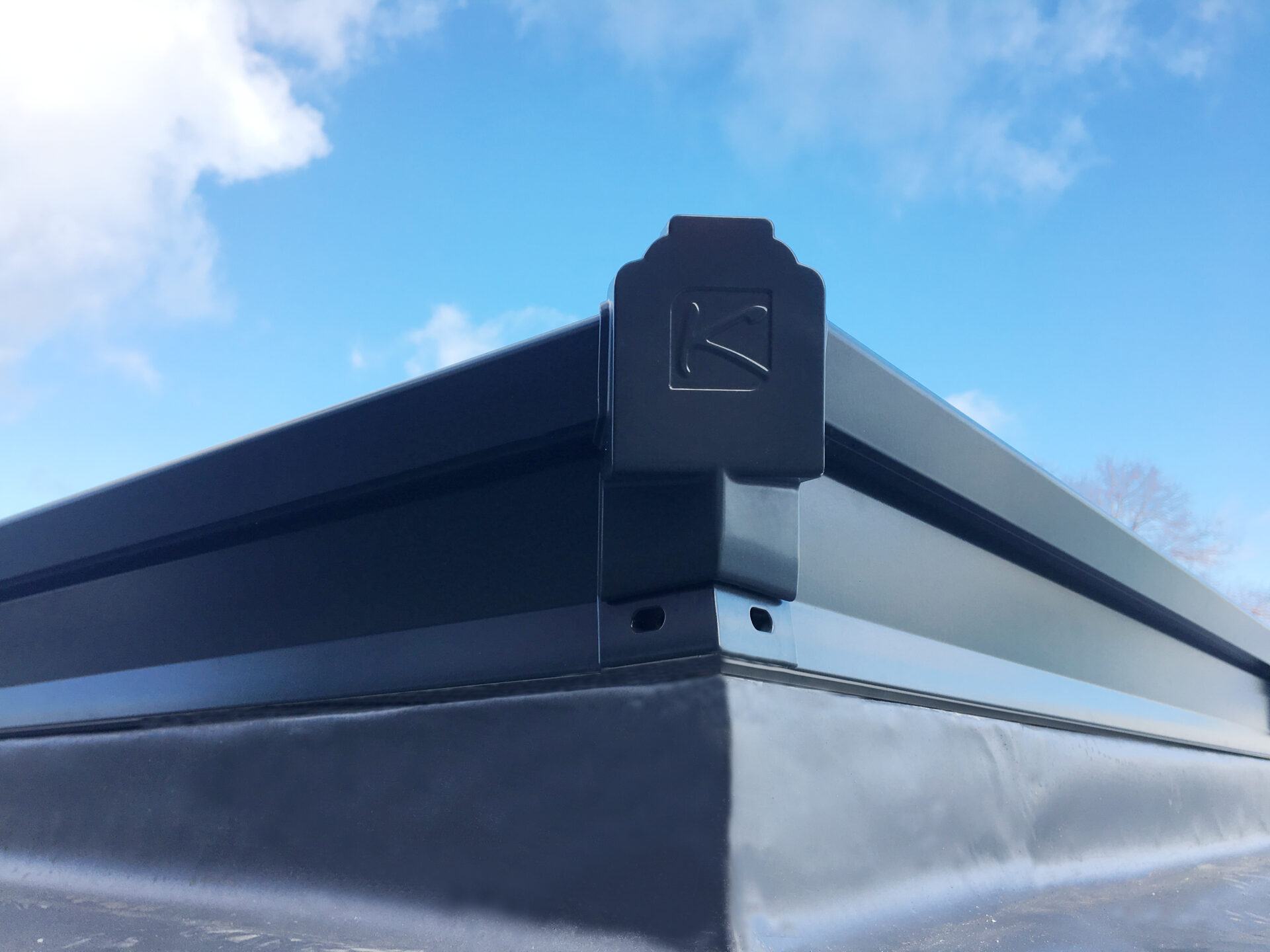Last Updated on 15 November 2024 by Team GFD
When dreaming of an ideal home, many homeowners dream of a constant flow of natural light streaming into their living spaces, creating an ambiance of warmth and spaciousness.
Roof lanterns, with their timeless elegance and functional benefits, have emerged as popular architectural features to fulfil this desire.
But as you embark on the journey of incorporating a roof lantern into your home, you may wonder: how high can a roof lantern upstand be?
In this comprehensive guide, we will explore this question and provide expert insights to help you create a captivating architectural focal point for your living space.
Need something specific? Jump ahead:
- What is a roof lantern upstand
- Importance of roof lantern design
- Factors influencing upstand height
- Benefits of roof lantern upstands
- Determining the optimal upstand height
- Installation process and considerations
- Structural considerations
- FAQs
What is a roof lantern upstand?
Before we delve into the intricacies of upstand heights, let’s establish a clear understanding of what a roof lantern upstand entails.
Essentially, the upstand refers to the vertical element that surrounds the base of the lantern and extends above the roofline. This integral component serves multiple purposes, including structural support, weatherproofing, and aesthetic enhancement.
Here’s an image showcasing our Korniche roof lantern securely mounted on an upstand.
Importance in roof lantern design
The upstand height holds significant importance in the design and functionality of a roof lantern. Beyond its structural role, the upstand profoundly impacts aspects such as natural light diffusion, ventilation, and overall visual appeal, both internally and externally.
Factors influencing upstand height
Numerous factors influence the determination of the optimal upstand height for your roof lantern. These factors encompass structural considerations, aesthetic preferences, and regulatory requirements:
Structural considerations
Ensuring the structural integrity of your roof is paramount when determining the upstand height. The upstand must complement the existing framework while providing adequate support for the lantern structure.
Aesthetic preferences
Your personal design preferences and architectural style will heavily influence the ideal upstand height. Whether you aspire for a sleek, modern look or a more traditional appearance, the upstand can be customised to align with your vision.
When it comes to enhancing natural light in your home, fitting a roof lantern can be a fantastic option.
Regulatory requirements
Building regulations stipulate minimum upstand heights to ensure proper drainage, prevent water ingress, and comply with safety standards. Familiarising yourself with these regulations is essential to avoid potential issues during the construction process.
Benefits of roof lantern upstands
Roof lantern upstands offer a range of benefits, including:
Enhanced natural light
One of the primary advantages of roof lantern upstands is their ability to facilitate the flood of natural light into your home. By elevating the lantern above the roofline, upstands maximise exposure to sunlight, creating a bright and inviting interior ambiance. This infusion of natural light not only enhances the aesthetic appeal of your living space but also contributes to a sense of spaciousness and well-being.
Improved ventilation
Strategically designed roof lantern upstands can also promote airflow and ventilation within your home. Through the incorporation of vents, upstands facilitate the exchange of indoor and outdoor air, promoting fresher, healthier indoor environments.
Proper ventilation helps regulate temperature levels, reduce moisture buildup, and mitigate the risk of mould and mildew growth, ensuring optimal comfort and air quality for occupants.
Architectural versatility
Beyond their functional benefits, roof lantern upstands offer architectural versatility, allowing for the integration of various design elements to complement your home’s aesthetic.
Whether you prefer a traditional, rustic look with timber upstands or a sleek, modern appearance with aluminium or uPVC options, the choice of materials and design details can be tailored to suit your style preferences and architectural vision.
Additionally, upstands can be customised in terms of size, shape, and finish to seamlessly integrate with your home’s existing design features and enhance its overall kerb appeal.
By harnessing the benefits of roof lantern upstands, homeowners can create vibrant, well-lit living spaces that exude warmth, comfort, and style.
All of our roof lanterns come with self-cleaning glass options as standard for easier maintenance.
Determining the optimal upstand height
To determine the perfect upstand height for your roof lantern, it is crucial to consider both interior and exterior factors:
Interior and exterior considerations
Internally, the upstand height should allow for sufficient headroom and facilitate optimal natural light penetration. Externally, it should harmonise with the roof pitch and architectural features while maximising visual impact.
Common upstand height ranges
Upstand heights for roof lanterns can vary depending on industry standards and customisation options:
Standard heights in construction
Typically, standard upstand heights vary between 100mm-300mm, though it’s recommended to use a 150mm upstand based on building regulations.
Customisation options
For those seeking a bespoke solution, upstand heights can be tailored to meet specific design objectives and preferences. Customisation offers unparalleled flexibility in achieving your desired aesthetic and functional goals.
Installation process and considerations
Installing a roof lantern upstand requires careful planning, precision, and attention to detail to ensure optimal performance and longevity. Let’s delve into the installation process and key considerations:
Professional installation
First and foremost, it’s essential to enlist the expertise of a qualified professional for the installation of your roof lantern upstand. A skilled contractor or roofing specialist will have the knowledge, experience, and equipment necessary to execute the installation safely and efficiently.
They will also ensure compliance with building codes and regulations, minimising the risk of structural issues or safety hazards down the line.
Structural integrity
Ensuring the structural integrity of your roof lantern upstand is paramount to its long-term stability and performance. During the installation process, the upstand must be securely anchored to the roof structure, providing adequate support and load distribution.
Additionally, proper waterproofing measures must be implemented to prevent water infiltration and damage, safeguarding the integrity of both the upstand and the surrounding roofing materials.
If you’re worried about heat build up, you may also want to read our ‘Do roof lanterns make the room hot?’ article.
Weatherproofing
Weatherproofing your roof lantern upstand is crucial to protecting your home against the elements and maintaining a leak-free interior. This involves the application of high-quality sealants and flashing materials to create a watertight barrier around the upstand perimeter. Attention to detail is key, as even minor gaps or inconsistencies can compromise the effectiveness of the weatherproofing system.
Regular inspections and maintenance are also recommended to identify and address any potential vulnerabilities before they escalate into more significant issues.
Structural considerations
Before proceeding with the installation, it’s important to assess the structural capacity of your roof to support the weight of the upstand and lantern assembly.
Factors such as roof pitch, load-bearing capacity, and existing framing must be taken into account to ensure compatibility and safety.
In some cases, structural modifications or reinforcements may be necessary to accommodate the additional weight and stress imposed by the roof lantern upstand.
Integration with roofing materials
The integration of the roof lantern upstand with the existing roofing materials is another critical consideration. Proper flashing and sealing techniques must be employed to create a seamless transition between the upstand and the surrounding roof surface, preventing water infiltration and potential leaks.
Compatibility with roofing materials such as tiles, shingles, or metal panels must also be ensured to achieve a cohesive and aesthetically pleasing finish.
Safety precautions
Throughout the installation process, adherence to safety protocols and best practices is essential to protect both workers and occupants. This includes the use of appropriate personal protective equipment (PPE), adherence to safety guidelines for working at heights, and securing the work area to prevent accidents or injuries.
Additionally, precautions should be taken to minimise disruption to the surrounding property and ensure the safe handling and disposal of construction debris.
By addressing these installation considerations with diligence and care, homeowners can ensure the successful integration of a roof lantern upstand into their home’s architecture, enhancing both its aesthetic appeal and functional performance.
Struggling to decide between roof lanterns vs roof lights and need some help? Just call us on 01642 309576 and we’ll help you choose the right fit for your home.
FAQs about Roof Lantern Upstands
Does a roof lantern need an upstand?
Yes, a roof lantern typically requires an upstand to provide structural stability, facilitate proper drainage, and enhance weather resistance.
Can I retrofit an existing roof with a roof lantern upstand?
Yes, it is possible to retrofit an existing roof with a roof lantern upstand, although it may require careful planning and structural modifications. Consult with a qualified contractor or architect to assess the feasibility of retrofitting and to ensure compliance with building regulations.
What is a 150mm upstand according to building regulations?
A 150mm upstand refers to the minimum height required by building regulations to ensure adequate water runoff and mitigate the risk of water infiltration.
In conclusion, the height of a roof lantern upstand is a critical consideration that profoundly influences both its performance and visual appeal. By carefully evaluating structural, aesthetic, and regulatory factors, you can determine the optimal upstand height to create a captivating architectural feature that elevates your living space.
For premium-quality roof lanterns that effortlessly blend form and function, we’d recommend exploring our extensive range of Korniche roof lanterns. Described as the ‘fastest lantern to install on the market’, we’re confident it’ll blow you away.

